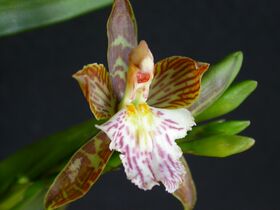Column (botany)

Catasetum schmidtianum flower. The column of male flowers of Catasetum do not have the female organs. They show a pair of thin structures called antennas which triger a shot of the pollinarium as far as five feet, which is intented to place the pollinarium on the right place on pollinators bodies.
column, or gynostemium, is a structure that can be found in the flowers of some plant families such as Aristolochiaceae, Orchidaceae, and Stylidiaceae. This structure is the result of the fusion of all sexual parts of the flower united in a single organ. In most of the orchid flowers the column in an elongated central structure which has been an important object of study by taxonomists along the years and is often used to largely separate and classify its genera and species.
The position, shape, proportion and structures present on the column are much variable but usually occupy the central place and all the other segments of the flower are placed in a way to favor pollinization and access only to the right agents to the pollen and stigma. Orchids evolved to maximize the chances of pollinization because, diferent from most flowers, their pollen is agregated on a pair number, from two to eight, of pellet structures called pollinia. Once the right pollinator comes, it takes away from the flower all pollen at once, so if this mass do not reaches its destiny, there is no second chance for the flower and all effort is wasted. On the other hand, most of orchid flowers are hermaphrodite so they still can be pollinated by an agent carrying the pollinia from another flower. To facilitate the pollination the labellum usually is the atracting structure. It may offer rewards, but ususally they just simulates they do and really reward nothing, or they have bright colors, they may mimetise insects inviting for a pseudocopula, the may form traps avoiding the insects to leave the flower before going through the stigma. Yet many other mechanisms are present.
At the base the column may be short or prolongated in a short or long structure called foot where the labellum is held. Is some orchids the labellum is attached laterally to the column making a sort of tunnel, in others is is very loosely hinged and moves with the wind. When the sepals are adnate to the column foot they may form a chin called mentum. Sometimes the lif also participates of this structure and they form a long tubular called calcar or nectarium.
Some columns have lateral structures called wings or arms which may have diferent purposes, sometimes is to keep the pollinators on the right track, other times they hold the labellum in a particular posision after it is touched by pollinators making its access easier.
The original and primitive position of the column in orchids shows the stigma facing up but most orchids twist their ovarium 180º so the flower is up side down and the lip works as a landing point. This twist is called ressupination. Sometimes orchids ressupinate 360º. Sometimes they do not ressupinate at all.
After the orchid flowers started ressupinating the collumn evolved in a way the we now refer to ventral area to what is in fact used to be primitively its dorsal area. Therefore, the stigma is generally located ventrally, opened towards the lip. The stigma, or female organ, has the form of a small bowl and may be hollow or deep, unilocular or divided in more sections.
It comunicates internaly or ventrally with the apex of the column, where usually the pollinia are located. Sometimes there is a small extension or little beak to the median stigma lobe, called rostellum which are held in place by a sort of viscous substance called viscidium. Some orchids have yet anore structure between the pollinia and viscidium called stipe.
The pollinia are covered by a strucure, generally of helmet format, called anther cap. This may be located at the exact apex of the column, over, or under it. The area of the column that embeds the anther cap is called clinandrium. The clinandrium may be smooth or serrilated, hooded of flat. The anther cap is shaped in a way it is released just when the polinator is leaving the flower, not on arrival, so this avoids flowers from being pollinated by their own pollen.
In almost all orchids each one of these structures evolved to match a particular insect or bird and totally depend upon them to their pollination. Very few species are cleistogamic, meaning they can self pollinate, actually there are species that even have separate male and female flowers to avoid this.

